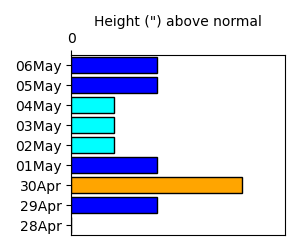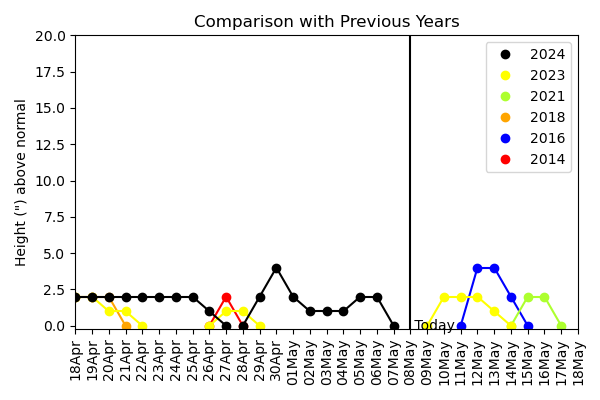Towpath Flooding
Below is a diagram showing areas of the towpath liable to flooding, which is periodically updated using the current EA river levels. The lowest area monitored is the path behind the Ice-Rink, which floods when the river reaches 16" above normal,

River Level
The plot below shows the relative level of the River Thames (known locally as 'The Isis') above Folly Bridge, judged against the steps on the left bank just below the footbridge on Friars Wharf [Map].
Below 6" above normal the river level is not a reliable indicator of flow so periods of Amber and Blue flag are just plotted as 4" and 2" respectively to show the duration of these periods.
Past experience suggests that the Red Flag will continue while the river remains more than 6" above normal and, when it starts to fall, it will drop a maximum of 3" per day (dotted line on the 'Comparison with Recent Years' plot below). On that basis, and assuming no further rain ...
Tuesday 16th December
(back two days since yesterday)

Comparison with Recent Years

The plot above shows the river level (expressed in inches above normal at Friar's Wharf) at this time of year in recent years, indicated by different colours. The data extend back to 2007 but only years when the river reached Blue Flag conditions or higher are shown (Blue flag plotted as 2", Amber flag as 4", everything else Red Flag).
External links
- Isis Flags
- EA Boards - Current Status
- EA Flood Status for the local area
- GaugeMap recording of Thames Flow Rate
- Farmoor (about 10m upstream)
- Sutton Courtenay (about 10m downstream)
-
EA River Levels
- Osney Lock (Upstream end of the Isis)
- Iffley Lock (Downstream end of the Isis)
- flags.jamesonlee.com (AI approach to flag prediction)
EA Gauges
The plot below shows recent levels recorded by the EA gauges at the upstream end of Iffley lock (IU) and the downstream end of Osney Lock (OD).

The green-bordered rectangle shows region within the EA definition of the 'Typical Range' for both gauges, with coloured bands indicating approximate ranges of different flag conditions (assuming that the flow rate is related to the OD-IU difference). Dotted lines are lines of constant (OD-IU) difference, i.e. approximately constant flow rate.
Solid squares, with dates, show the last 5 days, open squares are the most recent data for each flag type.
Flow Rate & Rainfall
The Osney-Iffley river level difference, which controls the flow speed (distance/time) can vary rapidly from day-to-day as the weirs are opened or closed, but a more smoothly varying quantity is the flow rate (volume/time), which is the product of flow speed x cross-section area. This is expected to increase rapidly following heavy rainfall (after a delay of about a day or two), and then smoothly decay back to a 'normal' level.

The plot above shows the past 30 days of daily rainfall (left-axis, bars), recorded by the AOPP Weather Station in central Oxford, and the estimated flow rate (right-axis, squares), derived as below.
Flow rate F [m3/s] is estimated from
The number 2.11m is the altitude difference between the reference points for the two locks. The factor 100 is chosen to convert to a flow rate which approximately matches the geometric average of the nearest Thames flow meters which are about 10 miles upstream (Farmoor) and 10 miles dowstream (Sutton Courtenay).
Forecast
The Forecast in the above plot assumes no further rain, and since 1st January 2024 has been based on a ground water model whose current state is shown below.
